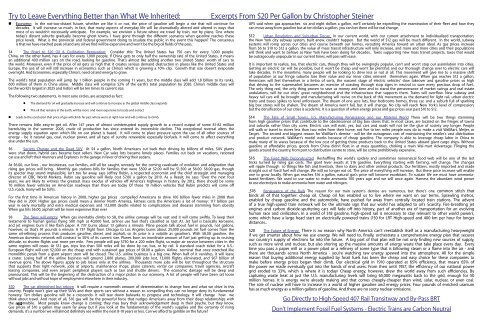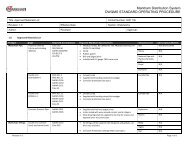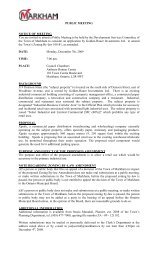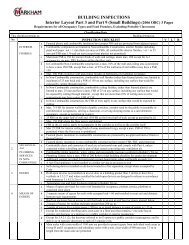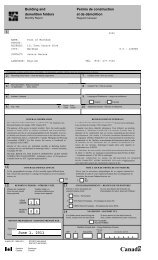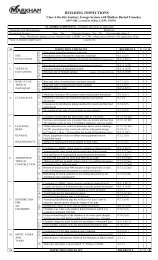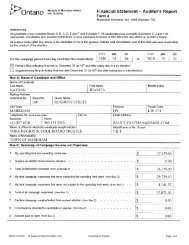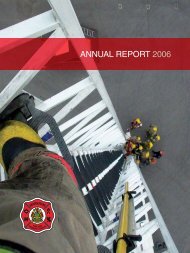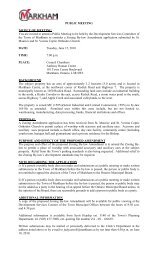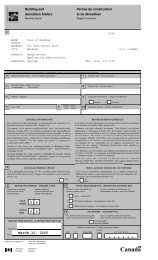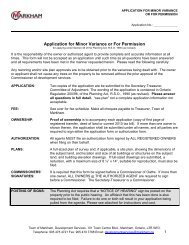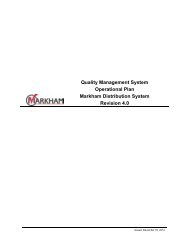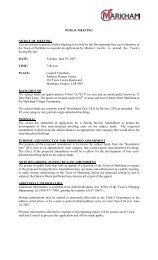1 4 7 10 11 12 2 5 8 3 6 9 - Town of Markham
1 4 7 10 11 12 2 5 8 3 6 9 - Town of Markham
1 4 7 10 11 12 2 5 8 3 6 9 - Town of Markham
You also want an ePaper? Increase the reach of your titles
YUMPU automatically turns print PDFs into web optimized ePapers that Google loves.
Try to Leave Everything Better than What We Inherited: Excerpts From $20 Per Gallon by Christopher Steiner<br />
Economy: In the not-too-distant future, whether we like it or not, the price <strong>of</strong> gasoline will begin a rise that will continue for<br />
decades. It will increase so much, in fact, that many aspects <strong>of</strong> everyday life will be dramatically altered and altered in ways that<br />
most <strong>of</strong> us wouldn’t necessarily anticipate. For example, we envision a future where we travel by train, not by plane. One where<br />
today’s distant suburbs gradually become ghost towns. I have gone through the different scenarios when gasoline reaches these<br />
price levels. What is the provincial and federal government doing to insulate the public in the event this happen? The consensus<br />
is that we have reached peak oil and any oil we find will be expensive and won’t be the big oil fields <strong>of</strong> the pass.<br />
$4 The Road to $20 Oil & Civilization Renovation: Consider this: The United States has 750 cars for every 1,000 people.<br />
China, on the other hand, has 4 cars for every 1,000 people. If China gets to only half the ownership rate <strong>of</strong> the United States, it means<br />
an additional 400 million cars on the road, looking for gasoline. That’s almost like adding another two United States’ worth <strong>of</strong> cars to<br />
the world. Moreover, even if the price <strong>of</strong> oil gets so high that it creates serious demand destruction in places like the United States and<br />
Europe, the use <strong>of</strong> oil will still increase in economics such as China’s which is growing a <strong>10</strong>% clip. Growth that size doesn’t evaporate<br />
overnight. And Economies, especially China’s, need oil and energy to grow.<br />
The world’s total population will jump by 1 billion people in the coming <strong>11</strong> years, but the middle class will add 1.8 billion to its ranks,<br />
600 million <strong>of</strong> them in China alone. Middle class will comprise 52% <strong>of</strong> the earth’s total population by 2020. China’s middle class will<br />
be the world’s largest in 2025 and India’s will be ten times its current size.<br />
The following two statements, in most sane circles, are accepted as fact:<br />
z The demand for oil will gradually increase and will continue to increase as the global middle class expands<br />
z The oil that remains in the earth, will be more and more expensive to locate and extract<br />
Leads to the conclusion that price <strong>of</strong> gas will climb far past where we’re at right now and will continue to climb.<br />
There remains little easy-to-get oil. After 147 years <strong>of</strong> almost uninterrupted supply growth to a record output <strong>of</strong> some 81-82 million<br />
barrels/day in the summer 2006, crude oil production has since entered its irreversible decline. This exceptional reversal alters the<br />
energy supply equation upon which life on our planet is based. It will come to place pressure upon the use <strong>of</strong> all other sources <strong>of</strong><br />
energy - be it natural gas, coal, nuclear power, and all type <strong>of</strong> sundry renewable especially bi<strong>of</strong>uels. It will come to affect everything<br />
else under the sun.<br />
$6 Society Change and the Dead SUV At $4 a gallon, North Americans cut back their driving by billions <strong>of</strong> miles. SUV plants<br />
were shut down, hybrid cars became best sellers. New Car sales lots became lonely places. Families cut back on vacations, rationed<br />
car use and left their 4runners and Explorers in the garage in favor <strong>of</strong> driving their sedans.<br />
At $6.00, our lives , our businesses, our families, will all be caught, unready for the coming cavalcade <strong>of</strong> evolution and adaptation that<br />
rising gas prices will bring. Monthly gas stations bills for families that were $500 at $2.00 will be $1,500 at $6.00. $6.00 gas, though<br />
its specter may sound implausible, isn’t too far away, says Jeffrey Rubin, a respected economist and the chief strategist and managing<br />
director <strong>of</strong> CIBC World Markets. Rubin say gasoline will likely cost $7.00 a gallon by 20<strong>10</strong>. As a Result, he says “Over the next four<br />
years, we are likely to witness the greatest mass exodus <strong>of</strong> vehicles <strong>of</strong>f America’s highways in history. By 20<strong>12</strong>, there should be some<br />
<strong>10</strong> million fewer vehicles on American roadways than there are today Of those <strong>10</strong> million vehicles that Rubin predicts will come <strong>of</strong>f<br />
U.S. roads, many will be SUVs.<br />
For the first time in American history in 2008, higher gas prices compelled Americans to drive <strong>10</strong>0 billion fewer miles in 2008 than<br />
they did in 2007. Higher gas prices could mean a skinner North America, Fatness costs the Americans a lot <strong>of</strong> money: <strong>11</strong>7 billion per<br />
year in early mortality and extra medical expenses and <strong>11</strong>2,000 deaths related to complications and diseases stemming from obesity<br />
When gas hits $6.00, asphalt will be more expensive than ever<br />
$8 The Skies will empty When gas inevitably climbs to $8, the airline carnage will be vast and it will come swiftly. To keep their<br />
testaments to human genius flying 500 mph at 40,000 feet, airlines use fuel that’s classified as Ujet A1. Jet fuel is basically kerosene,<br />
and jet engines burn it like flash paper. A 737 burns about 13 gallons a minute. Plane people talk about fuel in pounds, not gallons,<br />
however, so that’s 91 pounds a minute. A 737 flight from Chicago to Los Angeles burns about 25,000 pounds Jet fuel comes from the<br />
same oil-refining process that produces gasoline, diesel, and asphalt, so its price is a volatile as gasoline’s. With $8.00 gasoline, the<br />
American domestic network will contract to 50% <strong>of</strong> its current size. Planes burn an inordinate amount <strong>of</strong> fuel just getting up to cruising<br />
altitude, so shorter flights cost more per mile. Few people will pay $750 for a 200 miles flight, so major air service between cities in the<br />
same regions will cease. At $<strong>12</strong> gas, trips less than 500 miles will be done by car, bus, or by rail. A standard coach ticket for a U.S.-<br />
European flight will cost $2,000 on the cheap end with sustained gas prices <strong>of</strong> $8.00 a gallon. Airline terminal that once stretched like<br />
monolithic petals from a giant airport stem will be closed. The U.S. airline business is a big one. When half <strong>of</strong> it vanishes, it will leave<br />
a crater. Losing half <strong>of</strong> the airline business will ground 2,800 planes, 200,000 jobs lost, 13,000 flights eliminated, and $67 billion <strong>of</strong><br />
revenue gone. The above figures apply to job losses only at the airlines. Thousands more jobs will be lost throughout the structure<br />
that supports their light network, jobs at airports, maintenance shops, plane caterers, rental car companies, travel agencies, aircraft<br />
leasing companies, and even airport peripheral players such as taxi and shuttle drivers. The economic damage will be deep and<br />
pronounced. This will be the beginning <strong>of</strong> the destruction <strong>of</strong> a major piston in our economy. A lot <strong>of</strong> people will have been set loose<br />
without jobs and without hope <strong>of</strong> employment elsewhere in their industry.<br />
$<strong>10</strong> The car diminished but reborn It will require a mammoth amount <strong>of</strong> determination to change how and what we drive in this<br />
country. People won’t give up their SUVs and their sports cars without a reason so compelling they can no longer deny its fundamental<br />
honesty. Ten dollars gasoline will be a crescendo. It will tear down bulwarks to progress and technology. It will change how we<br />
think about travel. And most <strong>of</strong> all, $<strong>10</strong> gas will be the powerful force that nudges Americans away from their deep relationships with<br />
the automobile. 64 Most people know change is coming; they may bury their acknowledgement deep in their psyche, but they know.<br />
Gas prices <strong>of</strong> $<strong>10</strong> a gallon may seem far away but if you look at the fundamentals <strong>of</strong> the world’s supplies and the certainty <strong>of</strong> rising<br />
demands, it’s a number we will almost definitely see within the next 8-<strong>10</strong> years or less. Can we afford to gamble on the future?<br />
UPS said when gas approaches six and eight dollars a gallon, we’ll certainly be expediting the examination <strong>of</strong> their fleet and how they<br />
can move away from gasoline but at ten dollars a gallon, you can bet there will be real change.<br />
$<strong>12</strong> Urban Revolution and Suburban Decay In our current world, with our current attachment to individualized transportation,<br />
the New York city subway system, built anew, couldn’t happen. But the world <strong>of</strong> $<strong>12</strong> gas will be much different. In the world, subway<br />
systems will romp across our cities and course beneath our homes, rerouting America toward an urban ideal. As gas prices increase<br />
from $6 to $<strong>10</strong> to $<strong>12</strong> a gallon, the value <strong>of</strong> mass transit infrastructure will only increase, and more and more cities and their populations<br />
will think and want to behave as New York have been doing for decades. Taxes supporting new mass transit projects, taxes that would<br />
be outrageously unpopular in our current times, will pass with ease.<br />
It is important to realize, too, that electric cars, though they will be swingingly popular, can’t and won’t stop our assimilation into cities.<br />
Getting an electric car will be possible, but it won’t be cheap and won’t be plentiful; and our thorough change over to electric cars will<br />
take decades. In the meantime, many people will be looking to drive less or not al all. This movement will give rise to a massive shift<br />
<strong>of</strong> population as our fringe suburbs lose their value and our inner cities reinvent themselves again. When gas reaches $<strong>12</strong> a gallon,<br />
Americans will feel themselves in a limbo <strong>of</strong> sorts, the nascent stage <strong>of</strong> electric vehicles’ slow takeover and gasoline prices so high<br />
that driving to the supermarket becomes an exercise <strong>of</strong> coasting through stop signs in neutral to save every precious drop <strong>of</strong> fuel..<br />
The only thing real, the only thing proven to save us money and time and to stand the perseverance <strong>of</strong> market swings and real estate<br />
undulations, will be our cities’ great neighborhood and the infrastructure that supports them. Trains will overflow. New subway and<br />
heavy rail cars will be brought and manufacturing will revive on the back <strong>of</strong> this movement as the demand for light rail, urban electric<br />
trains and buses spikes to level unforeseen. The dream <strong>of</strong> one acre lots, four bedrooms homes, three car, and a suburb full <strong>of</strong> sparking<br />
big box stores will be shaken. The dream <strong>of</strong> America won’t fail, but it will change. No city will reach New York’s level <strong>of</strong> compression;<br />
but the densification <strong>of</strong> our cities is academic. It is a question <strong>of</strong> when energy prices and gas prices soar past $<strong>10</strong> to $<strong>12</strong>.<br />
$14 The Fate <strong>of</strong> Small <strong>Town</strong>s, U.S. Manufacturing Renaissance and our Material World There will be two things stemming<br />
from high gasoline prices that contribute to the obsolescence <strong>of</strong> big box stores that, in most cases, are located on the fringes <strong>of</strong> towns<br />
and suburbs rather than city cores. Electric cars will exist, yes, but cars and roads will not be the glue <strong>of</strong> society any longer. People<br />
will walk or travel to stores less than two miles from their home, not five to ten miles people now do to make a visit WalMart, Meijer, or<br />
Target. The second and biggest reason for WalMart’s demise - will be the outrageous cost <strong>of</strong> maintaining the retailer’s vast distribution<br />
and product network. WalMart’s model works because <strong>of</strong> cheap gasoline. The company is able to leverage cheap labor in China to<br />
make many <strong>of</strong> its wares because <strong>of</strong> the low cost <strong>of</strong> getting those products back to the United States aboard giant cargo ships. Without<br />
gasoline at affordable prices, goods from China didn’t float in at mass quantities, choking a main Wal-mart Advantage. Flinging the<br />
goods around the country, from port to distribution centre to store, will be come prohibitively expensive.<br />
$16 The Food Web Deconstructed Reshuffling the world’s spidery and sometimes nonsensical food web will be one <strong>of</strong> the last<br />
tricks turned by rising gas costs. The giant lever awaits at $16 gasoline. Everything starting with farming, will change. The changes<br />
will ripple through to things like fish and livestock, then to dairy and other animal products. Our fertilizers, mostly imported and made<br />
straight out <strong>of</strong> fossil fuel will change. We will no longer eat oil. The price <strong>of</strong> everything will increase, But these price increase will enable<br />
one to grow locally. When gas reaches $16 a gallon, natural gas’s price will become exorbitant. To sustain life we must have ammoniabased<br />
fertilizers. We used to use water to make ammonia <strong>10</strong>0 years ago and we will once again. Harness the abundant wind power<br />
to use electrolysis to make ammonia from water and nitrogen.<br />
$18 Renaissance <strong>of</strong> the Rails The reason for our train system’s demise are numerous, but there’s one common stitch that<br />
binds all <strong>of</strong> that together: cheap oil. Cheap oil has enabled us to live where we want on our terms. Sprawling metros,<br />
enabled by cheap gasoline and the automobile, have pushed far away from centrally located train stations. The advent<br />
<strong>of</strong> a true high-speed train network will be the ultimate sign that our world has adapted to oil‘s Scarcity. Fire-breathing jet<br />
engines and carbon dioxide-sputtering cars will fade <strong>of</strong>f into history, part <strong>of</strong> another era <strong>of</strong> transportation for an evolving<br />
human race and civilization. In a world <strong>of</strong> $18 gasoline, high-speed rail is necessary to stay relevant to other world powers,<br />
some which have a large head start on electrically powered trains (150 for LRT High-speed and 400 km per hour for longer<br />
distances..<br />
$20 The Future <strong>of</strong> Energy There is no reason why North America can’t reestablish itself as a manufacturing heavyweight<br />
if we get smarter about how we use energy. We will need to, finally, orchestrate a comprehensive energy plan that secures<br />
our country’s supply <strong>of</strong> electrons far into the future. A big part <strong>of</strong> that plan will be not only finding new sources <strong>of</strong> supply,<br />
such as more wind and nuclear, but also shoring up the massive amounts <strong>of</strong> energy waste that take place every day. Every<br />
time you pass a paper mill or a power plant or a refinery <strong>of</strong> some type that is billowing steam or a flame into the air - and<br />
there are thousands across North America - you’re watching raw energy spewed into the atmosphere. All for the simple<br />
reason that buying additional energy supplied by fossil fuels has been the cheap and easy choice for these companies to<br />
make before energy prices began their climb. Our electrical grid in 19<strong>10</strong> operated at 65% efficiency, that means 65% <strong>of</strong><br />
the power we made eventually got into the hands <strong>of</strong> end users. From then until 1957, the efficiency <strong>of</strong> our national power<br />
grid eroded to 33%, which is where it is today/ Cheap energy, however, drew the world away from such efficiencies. By<br />
capturing waste heat at just the U.S. manufacturing levels will bring 65,000 megawatts back to the grid, enough for 50<br />
million homes. It is energy we’re already making and that comes cheaply-cheaper than wind, solar, nuclear, or even coal.<br />
The role <strong>of</strong> nuclear will have to increase in a world <strong>of</strong> higher gasoline and energy prices. Four pounds <strong>of</strong> enriched uranium<br />
has as much energy as a million gallons <strong>of</strong> gasoline. And there are no sooty nuclear emissions.<br />
Go Directly to High-Speed 407 Rail Transitway and By-Pass BRT<br />
Don’t Implement Fossil Fuel Systems - Electric Trains are Carbon Neutral


